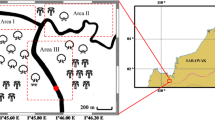Abstract
Lead, mercury and cadmium concentrations were measured in muscle, liver and gill in wild and farmed Barbus sharpeyi from Shadegan Wetland (SW) and Azadegan Aquaculture Site (AAS). Significant variation in metal values were evaluated in Students’ tests at p > 0.05. Results showed: In B. sharpeyi high levels of cadmium, lead, and mercury were measured in gill (0.34, 0.68, and 0.06 mg kg−1 dw). The concentration of metals was not significantly different (p ≥ 0.05) in the muscle between SW (Cd, 0.24; Pb, 0.49 and Hg, 0.04) and AAS (Cd, 0.23; Pb, 0.49 and Hg, 0.04). Lead concentration was higher than cadmium and mercury in different organs (p > 0.05). Cadmium, mercury and lead in different tissues of SW were higher than AAS and there was no significant difference between them (p ≥ 0.05). Metal levels in different tissues were higher than WHO standard.
Similar content being viewed by others
References
Alhas E, Oymak SA, Akin HK (2009) Heavy metal concentrations in two barb, Barbus xanthopterus and Barbus rajanorum mystaceus from Atatürk Dam Lake, Turkey. Environ Monit Assess 148:11–18
Al-Yousuf MH, El-Shahawi MS, Al-Ghais SM (2000) Trace metals in liver, skin and muscle of (Lethrinus lentjan) fish species in relation to body length and sex. Sci Total Environ 256:87–94
Canli M, Furness RW (1993) Toxicity of heavy metals dissolved in sea water and influences of sex and size on metal accumulation and tissue distribution in the Norway lobster Nephrops norvegicus. Mar Environ Toxicol Chem 14:819–828
Clearwater SG, Baskin SJ, Wood CM, MacDonald DG (2000) Gastrointestinal uptake and distribution of copper in rainbow trout. J Exp Biol 203:2455–2466
Fadrus H, Maly J, Sedlack M (1979) In: Invasion of heavy metals into the aqueous environment and means of their control. Management and control of heavy metals in the environment, pp 493–496
Farag AM, Stansburgh MA, Hogstrand C, MacConnell E, Bergman HL (1995) The physiological impairment of free-ranging brown trout. Exposed to metals in the Clark Fork River, Montana. Can J Fish Aquact Sci 52:2038–2050
Fernandes C, Fontainhas-Fernandes A, Cabral D, Salgado MA (2008) Heavy metals in water, sediment and tissues of Liza saliens from Esmoriz-Paramos lagoon, Portugal. Environ Monit Assess 136:267–275
Filazi A, Baskaya R, Kum C (2003) Metal concentration in tissues of the Black Sea fish Mugil auratus from Sinop-Icliman, Turkey. Hum Exp Toxicol 22:85–87
Heath AG (1987) Water pollution and fish physiology. CRC Press, Boca Raton, p 245
Karadede H, Oymak SA, Unlu E (2004) Heavy metals in mullet, Lizze abu, and catfish, Silurus triostegus, from the Ataturk Dam Lake. J Environ Int 30(2):183–188
Linde AR, Sanchez-Galan S, Izquierdo JI, Arribas P, Maranon E, Garcya-Vazquez E (1998) Brown Trout as biomonitor of heavy metal pollution: effect of age on the reliability of the assessment. Ecotoxicol Environ Saf 40:120–125
Malik N, Biswas AK, Qureshi TA, Borana K, Virha R (2010) Bioaccumulation of heavy metals in fish tissues of a fresh water lake of Bhopal. J Environ Monit Assess 160(4):267–276
Meador JP, Clark RC Jr, Robisch PA, Ernest DW, Landahl JT, Varanasi U et al (1994) National benthic surveillance project: Pacific Coast. Trace element analyses for cycles I to V (1984–1988). National Oceanic and Atmospheric Administration, National Marine Fisheries Service Technical MemorandumNMFSNWFSC-16, p 206
Mohammadi M, Askary Sary A, Khodadadi M (2011) Determination of heavy metals in two barbs, Barbus grypus and Barbus xanthopterus in Karoon and Dez Rivers, Khoozestan, Iran. Bull Environ Contam Toxicol 87(2):158–162
Pourang N (1995) Heavy metal bioaccumulation in different tissues of two fish species with regards to their feeding habits and trophic levels. Environ Monit Assess 35:207–219
Rashed MN (2001) Monitoring of environmental heavy metals in fish from Nasser Lake. Environ Int 27:27–33
Romeo M, Siau Y, Sidoumou Z, Gnassia-Barelli M (1999) Heavy metal distribution in different fish species from the Mauritania coast. Sci Total Environ 232:169–175
Tawari-Fufeyin P, Ekaye SA (2007) Fish species diversity as indicator of pollution in Ikpoba river, Benin City, Nigeria. Rev Fish Biol Fisheries 17:21–30
UNEP (1991) Sampling of selected marine organisms and sample preparation for the analysis of chlorinated hydrocarbons reference methods for marine pollution studies No. 12, Rev. 2, UNEP, Nairobi, p 17
WHO (1985) Review of potentially harmful substances—cadmium, lead and tin. WHO, Geneva (reports and studies No. 22. MO/FAO/UNESCO/WMO/WHO/IAEA/UN/UNEP joint group of experts on the scientific aspects of marine pollution)
Author information
Authors and Affiliations
Corresponding author
Rights and permissions
About this article
Cite this article
Taravati, S., Askary Sary, A. & Javaheri Baboli, M. Determination of Lead, Mercury and Cadmium in Wild and Farmed Barbus sharpeyi from Shadegan Wetland and Azadegan Aquaculture Site, South of Iran. Bull Environ Contam Toxicol 89, 78–81 (2012). https://doi.org/10.1007/s00128-012-0604-0
Received:
Accepted:
Published:
Issue Date:
DOI: https://doi.org/10.1007/s00128-012-0604-0




